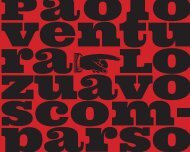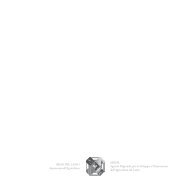Giuseppe Cavalli
Giuseppe Cavalli
Giuseppe Cavalli
- No tags were found...
You also want an ePaper? Increase the reach of your titles
YUMPU automatically turns print PDFs into web optimized ePapers that Google loves.
182<br />
ject has no importance in art, since light and poetry are its permanent subjects.<br />
<strong>Giuseppe</strong> <strong>Cavalli</strong>’s still lifes are truly remarkable. In them he succeeds in bringing to ordinary, everyday objects<br />
such as funnels, gloves and the like, a compelling lyrical quality that goes well beyond the simplicity of the things<br />
depicted. It is these images of his that are closest to the abstract or metaphysical artistic themes of his time. The<br />
same well-organized forms and beautiful almost abstract composition between the metaphysical and symbolic, are<br />
to be found also in his views with landscapes and seascapes. They are images of cities, but mostly of nature and the<br />
countryside, from his native Puglia to the Marches region. In fact, <strong>Cavalli</strong> settled in Senigallia in the Marche in 1939,<br />
after spending a long period in Rome with his family, and frequenting the Milanese cultural milieu in which La<br />
Bussola was formed. The quiet landscape of the Marche and the sea at Senigallia with its long straight coastline,<br />
thus provided the inspiration for his creations, and it was here that he established, with Mario Giacomelli, the Misa<br />
photographic association, which forged many of the new talents who appeared on the Italian photographic scene in<br />
the Fifties.<br />
These views were also the figurative means through which <strong>Giuseppe</strong> <strong>Cavalli</strong> expressed his photographic poetics,<br />
as he did in his still lifes. In art the subject has no importance, the important thing is to succeed in depicting the<br />
essence and spirit of things also through unassuming, everyday images.<br />
It is as if the objects, scenery, architecture and even the people photographed by him were extrapolated, as if by<br />
magic, from the common reality and objectiveness that derives from being in a specific place when the photograph<br />
was taken, into the world of imagination or, better, of art. <strong>Cavalli</strong> himself helps viewers to follow this transition with<br />
his evocative titles: Shadows on a Face, Spring Games, Mystery of the River, Geometry. Titles that are far from literal<br />
and do much more than simply describe what is depicted in these photographs: respectively a boy’s face, a tiny<br />
group of people on a vast beach, a stretch of river and a long railing. Through their simplicity and pureness they<br />
speak a universal language.<br />
Much has been said about the affinity between <strong>Cavalli</strong>’s photographs and the world of painting, with which he<br />
was familiar also through the experiences of his brothers Emanuele and Pasquale. In the course of his career spanning<br />
over a quarter of a century, he drew his inspiration from many twentieth-century painting movements, from<br />
Metaphysical Painting to Surrealism and Abstractionism. But his work cannot be confined to any one of these, its<br />
only constant being the bright high-key quality with tones verging on white.<br />
Unlike a painter who creates the subjects of his paintings, <strong>Cavalli</strong> communicates with us through the subjects at<br />
hand or those he seeks out. Thus, like all great photographers, he was able to ‘seize the moment’ if an image or shot<br />
was meaningful enough, or to wait at length, with the patience of a hunter – or rather fisherman, considering his<br />
love for the sea – until the light reached the desired intensity, a sail in the middle of the sea arrived at the right point<br />
or a gust of wind bent the branch of a tree in a particular way, so that things, people and nature came together to<br />
create the desired composition.







